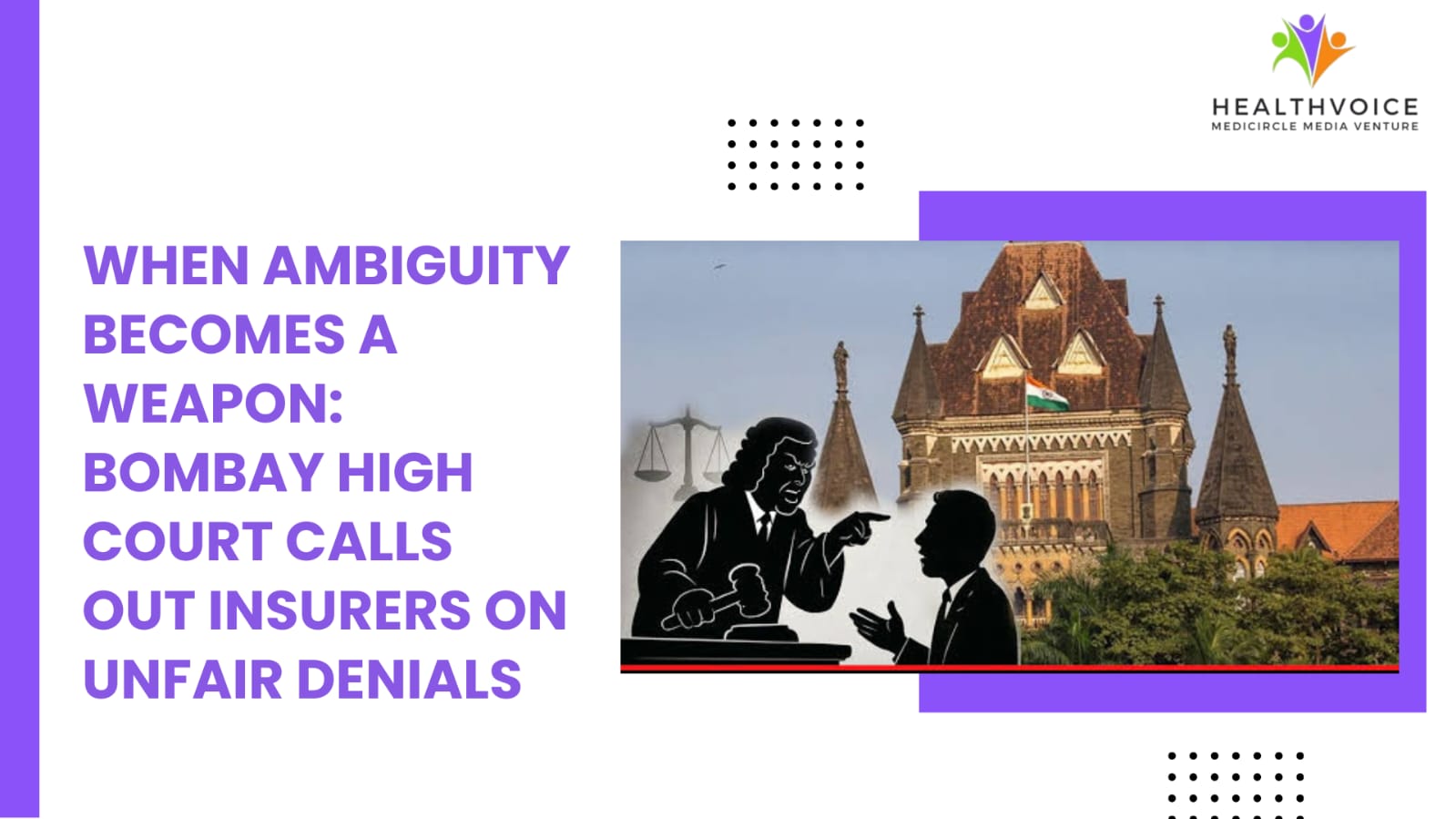When Ambiguity Becomes a Weapon: Bombay High Court Calls Out Insurers on Unfair Denials
This case challenges insurers to act with integrity, urges regulators to simplify and clarify, and reassures families that ambiguity cannot always be weaponised against them.

Insurance, in its essence, is meant to be a shield of protection against life’s uncertainties. Families invest their hopes and savings into it, believing that when tragedy strikes, the promised safety net will rise to catch them. Yet, in India’s growing healthcare and financial landscape, insurance has too often become a battleground of fine print, ambiguous clauses, and technical interpretations. The recent ruling of the Bombay High Court in the case involving TATA AIG General Insurance Company and the widow of a borrower who died of a sudden cardiac arrest has once again exposed the fragile trust between insurers and the insured. The verdict brought back into sharp focus the ethical responsibilities of insurers, the vulnerability of policyholders, and the principle that when words are unclear, fairness must tilt towards the weaker party.
At the centre of this legal dispute was a woman who lost her husband unexpectedly to a sudden cardiac arrest. He had availed of a compulsory credit-linked insurance policy bundled with his housing loan, a practice increasingly common in the financial sector. The promise was simple: if something happened to him, the insurance would step in to clear the liability, sparing his family from the crushing burden of repayment. But when the tragedy unfolded and his widow approached the insurer, the promise evaporated into a maze of conditions and arguments. TATA AIG refused to honour the claim, stating that no diagnostic evidence proved the death as one of the “critical illnesses” covered by the policy. The irony was that the man collapsed, was hospitalised, and died within minutes. The treating doctor clearly recorded cardiac arrest as the cause of death. Yet the absence of paperwork in those frantic, fleeting moments was twisted into a justification for denial.
This is where the Bombay High Court stepped in. Justice Sandeep V. Marne, in a strongly worded order, dismantled the insurer’s stance, highlighting that the principle of contra proferentem applies squarely in cases of ambiguous policies. This principle, long recognised in contract law, dictates that when an insurance document is open to multiple interpretations, the meaning most favourable to the policyholder must prevail. It is not just a legal technicality, it is a doctrine that protects ordinary citizens from being crushed by the complex and often one-sided language drafted by corporations.
The Court emphasised that the very object of bundling such insurance with housing loans is to secure repayment in the event of a borrower’s death. To deny coverage on the grounds that the insured did not survive long enough to generate diagnostic paperwork would not only defeat the purpose of the scheme but also turn the policy into an absurdity. What value is an insurance product if it fails precisely at the moment it was purchased for? The judges saw through this attempt at evasion and refused to allow hyper-technical arguments to prevail over justice.
What makes this ruling so significant is not just its outcome, but the broader questions it forces us to confront. How many families, lacking the resources or resilience to fight a legal battle, quietly surrender when their claims are rejected? How often do technical interpretations replace the spirit of protection that insurance is meant to provide? And how does this growing mistrust impact the very fabric of healthcare financing in India, where insurance penetration is still far from adequate?
The healthcare sector has long argued that insurance should be the backbone of accessible treatment, reducing the crushing burden of out-of-pocket expenses that devastate families. For doctors and hospitals, timely claim settlements are essential for sustaining patient trust. Yet the frequent stories of rejection, delay, and dispute create an atmosphere where both patients and providers hesitate to rely on insurers. The Bombay High Court’s reminder that insurers cannot weaponise ambiguity is, therefore, more than a legal precedent, it is a moral directive to the industry.
The case also highlights another troubling dimension: the role of bundled insurance policies. Banks and housing finance companies increasingly mandate credit-linked insurance to safeguard their loans. While this practice seems beneficial on paper, it often leaves borrowers with little clarity on the exact terms, exclusions, and limitations of the policy they are compelled to accept. The fine print is seldom explained, and the product is rarely chosen with informed consent. When tragedy occurs, families find themselves battling not just grief but also the opacity of contracts they barely understood. This is where judicial interpretation becomes a lifeline, ensuring that such mandatory schemes do not become traps.
For doctors and healthcare professionals, the ruling has lessons that go beyond law. The Court’s reliance on the treating doctor’s testimony over the insurer’s panel physician is a striking recognition of frontline medical judgment. The treating doctor had certified that the patient died of cardiac arrest, and the Court made it clear that this firsthand assessment could not be casually brushed aside by an expert who never examined the patient. In doing so, the Court reaffirmed the value of clinical judgment and direct observation, a reminder in an age of digital records and algorithmic assessments that medicine remains a discipline rooted in human expertise.
It is worth recalling that cardiac arrest, unlike many chronic conditions, is often sudden and terminal within minutes. Expecting diagnostic tests in such situations is unrealistic and unfair. The Court noted precisely this, cautioning that absence of tests cannot be weaponised to deny claims. This acknowledgment of medical realities should encourage greater alignment between legal frameworks, insurance practices, and clinical truths.
Beyond the specifics, this case connects to a larger conversation around the rise of insurance disputes in India. Reports have repeatedly shown that repudiation of claims is one of the biggest sources of grievance among policyholders. The reasons range from alleged non-disclosure of pre-existing conditions to technical lapses in documentation, many of which reveal a disturbing imbalance of power. For widows, orphans, and families already struggling with loss, navigating such disputes is emotionally and financially exhausting. Very few can afford prolonged litigation, making this Bombay High Court ruling a ray of hope for many silent sufferers.
The Court also did not mince words about the insurer’s conduct, observing that TATA AIG’s approach lacked bona fides and that the company had forced the widow into four years of unnecessary litigation. It even remarked that costs could justifiably have been imposed on the insurer for this behaviour. Such judicial rebukes are rare but necessary. They signal to the industry that denial without fairness will not go unchallenged, and they remind policyholders that the judiciary can, at times, tilt the scales of justice back towards equity.
The case underlines the urgent need for greater transparency in insurance contracts. If ambiguity is consistently leading to disputes, then regulators such as the Insurance Regulatory and Development Authority of India (IRDAI) must step in with clearer guidelines. Policy wordings should not require judicial interpretation; they should be written in language that ordinary citizens can understand. Standardisation of critical illness definitions, disclosure requirements, and claim processes could prevent many such conflicts.
For doctors and healthcare leaders reading this, there is an added dimension worth considering. The credibility of insurance is directly tied to the functioning of the healthcare system. When insurers deny claims unjustly, patients faith in hospitals and physicians is indirectly affected. The promise of financial protection becomes hollow, and the public’s perception of healthcare financing weakens. As stakeholders in patient welfare, medical professionals have a role in advocating for fair insurance practices, aligning with patient rights groups, and lending their voices to regulatory reforms.
The case also sheds light on the human cost of litigation. Four years of battling in court for what was rightfully due is not just a financial ordeal but an emotional burden. It forces families into prolonged distress, delays closure, and compounds the trauma of loss. In a country striving to build trust in insurance as a vehicle for health security, such experiences are deeply counterproductive. The message from the Bombay High Court is clear: insurers must not forget the human beings behind their contracts.
Ultimately, the ruling is a reminder that justice lies not in technicalities but in intention. Insurance exists to protect, not to profit from ambiguity. Doctors, patients, insurers, and policymakers must recognise that in a country where healthcare costs are rising and access remains uneven, the role of insurance is too vital to be eroded by mistrust. When the Bombay High Court sided with the widow, it upheld the spirit of fairness that insurance should embody.
As the healthcare and insurance sectors continue to intertwine in India’s evolving system, this case will remain a landmark. It challenges insurers to act with integrity, urges regulators to simplify and clarify, and reassures families that ambiguity cannot always be weaponised against them. For the medical fraternity, it reaffirms the authority of clinical judgment and highlights the interconnectedness of law, policy, and practice.
In the end, the true test of an insurance policy is not in its pages but in its performance at the moment of crisis. When that moment arrives, justice demands that ambiguity bend towards compassion, not corporate convenience
 Sunny Parayan
Sunny Parayan
#healthvoice #BombayHighCourt #InsuranceJustice #ProtectFamilies #HealthcareForAll #FairInsurance #Policyholder #CriticalIllness #TrustInInsurance #IRDAI
